Submerged aquatic vegetation (SAV) is the foundation of our river’s health – providing biofiltration, fish habitat, and more. Sadly, the St. Johns River is suffering mounting threats resulting in the near demise of our river’s SAV. In search of solutions, St. Johns RIVERKEEPER (SJRK) launched a 5-year effort, the SAVe our River’s Grasses Expedition, earlier this year.
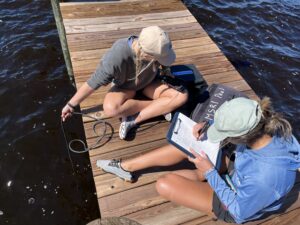 In October, SJRK returned to the river for its third and final sampling tour of the 2023 SAV growing season. Over four days, our team once again surveyed an 80-mile stretch of the river between Doctors Lake and Lake George searching for remaining grass beds, taking measurements, conducting water quality testing, and seeking solutions to restore this vital habitat.
In October, SJRK returned to the river for its third and final sampling tour of the 2023 SAV growing season. Over four days, our team once again surveyed an 80-mile stretch of the river between Doctors Lake and Lake George searching for remaining grass beds, taking measurements, conducting water quality testing, and seeking solutions to restore this vital habitat.
Due to king tides, wind and rising water levels, the river bottom at each site was too deep for the team’s regular mapping procedures. As a result, the SJRK SAV team had to implement adaptations to its sampling protocols including a hand/foot survey instead of submerged quadrat and intercept sampling. This involved feeling with feet and hands along the designated transect line and estimating percent cover in areas where SAV was present. SAV canopy height, species, and water depth were all recorded consistent with previous protocols.
We also met with riverfront residents, community leaders, scientists, anglers and river enthusiasts deepening our connection, developing our joint path forward and sharing our sense of value for our river.
 Engaging the Community
Engaging the Community
On October 18, we held our second event in the Brewing Up Solutions – Putnam series at downtown Palatka’s Azalea City Brewing. We met with conservationists and area residents to discuss the importance of the St. Johns River’s submerged aquatic vegetation (SAV) to the river’s health and to its fisheries, as well as the importance of protecting and restoring our land, wild spaces and wetlands. Former SJRK Board Member Ben Williams helped lead the discussion with the St. Johns Riverkeeper, Lisa Rinaman. Over a tasty brew, we explored how we can all work together to address the health of the St. Johns and the state of the river’s SAV.
 Seeking Solutions: Fencing Project
Seeking Solutions: Fencing Project
SJRK met with Georgetown homeowners on Friday, October 20, to gauge interest in a pilot fencing initiative to protect SAV from grazers, based on protective enclosures built by the Florida Fish and Wildlife Conservation Commission (FWC) and local bass anglers. SJRK is developing a program to complement FWC’s efforts by working with homeowners and bass anglers to install smaller enclosures along our Expedition route in early 2024. Permitting and supply investigations for this project are under way.
As you’ll see in our summary below, we’ve already seen the presence of thriving grasses within enclosures that exist at some of our sampling sites.
 Summary of October’s Findings
Summary of October’s Findings
- The SJRK SAV Expedition Team once again found fledgling grasses at the Doctors Lake site, as we did back in August, where none existed during the May 2023 Expedition.
- SAV was also found at the Fruit Cove site. The river’s grasses were more widespread at this location but cropped short by hungry grazers, most likely turtles and/or manatees as we found throughout the Expedition route with the exception of SAV within the protective FWC enclosures.
- One of the most exciting highlights was the presence of long, healthy grasses within Dancy Point’s three acre enclosure & San Mateo’s smaller enclosure. The Dancy Point enclosure is part of a FWC’s project to protect grasses from grazers, giving our river’s SAV a fighting chance to grow, germinate and spread. Inside the enclosure, SAV canopy continues to grow at an impressive rate with highest canopy heights recorded at 7 cm in May, 25 cm in August and 105 cm in October. Average October canopy height inside the fence was 45.5cm with an average percent cover of 60%. Outside the Dancy Point enclosure, SAV was cropped short at an average height of 1.8cm and 41% coverage, similar to the other unprotected areas, demonstrating the significant grazing pressure due to limited SAV food sources throughout the Lower St. Johns.
 Chara, an SAV that is a type of macroalgae, was once again observed at the Welaka and Drayton Island sites, but it was much more sparse than in August and May. Chara was not found at the Beecher Point site, where it was quite abundant during our May and August surveys. The lack of Chara could potentially be a result of wind action and high water levels of recent Hurricane Idalia, but this is unconfirmed. SJRWMD scientists consider Chara to be a precursor species to eelgrass. The SJRK SAV Team and area residents hope to see eelgrass presence in the 2024 growing season.
Chara, an SAV that is a type of macroalgae, was once again observed at the Welaka and Drayton Island sites, but it was much more sparse than in August and May. Chara was not found at the Beecher Point site, where it was quite abundant during our May and August surveys. The lack of Chara could potentially be a result of wind action and high water levels of recent Hurricane Idalia, but this is unconfirmed. SJRWMD scientists consider Chara to be a precursor species to eelgrass. The SJRK SAV Team and area residents hope to see eelgrass presence in the 2024 growing season.
October 2023 Field Log Coming Soon
We will be publishing a Field Log soon containing a more detailed analysis of our findings from the October 2023 SAVe our River’s Grasses Expedition. You can find all of our past field logs and the 2023 Expedition Overview here.
For the River. For us All.
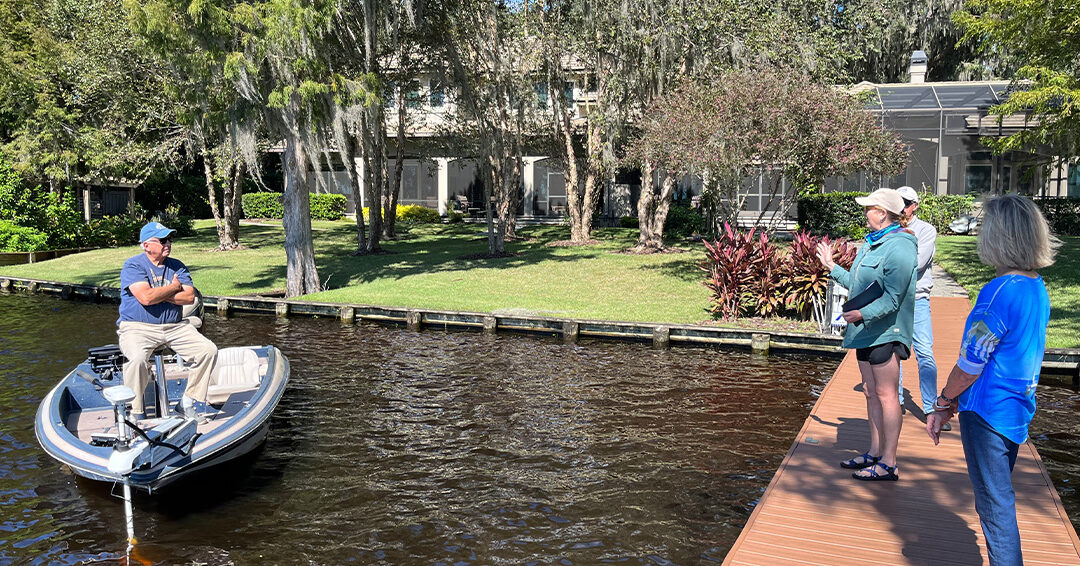
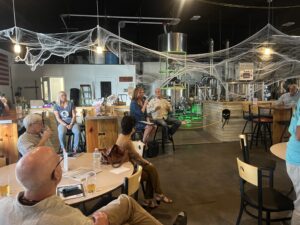 Engaging the Community
Engaging the Community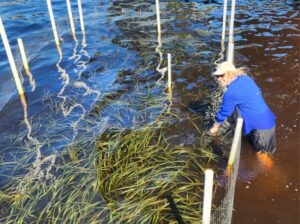 Seeking Solutions: Fencing Project
Seeking Solutions: Fencing Project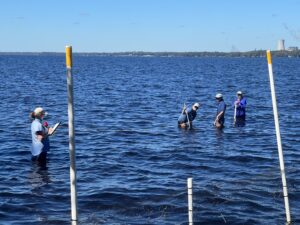 Summary of October’s Findings
Summary of October’s Findings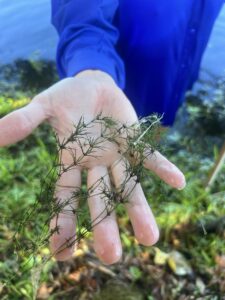 Chara, an SAV that is a type of macroalgae, was once again observed at the Welaka and Drayton Island sites, but it was much more sparse than in August and May. Chara was not found at the Beecher Point site, where it was quite abundant during our May and August surveys. The lack of Chara could potentially be a result of wind action and high water levels of recent Hurricane Idalia, but this is unconfirmed. SJRWMD scientists consider Chara to be a precursor species to eelgrass. The SJRK SAV Team and area residents hope to see eelgrass presence in the 2024 growing season.
Chara, an SAV that is a type of macroalgae, was once again observed at the Welaka and Drayton Island sites, but it was much more sparse than in August and May. Chara was not found at the Beecher Point site, where it was quite abundant during our May and August surveys. The lack of Chara could potentially be a result of wind action and high water levels of recent Hurricane Idalia, but this is unconfirmed. SJRWMD scientists consider Chara to be a precursor species to eelgrass. The SJRK SAV Team and area residents hope to see eelgrass presence in the 2024 growing season.